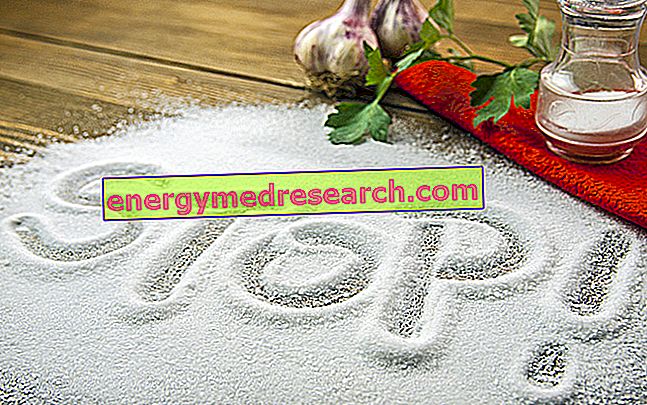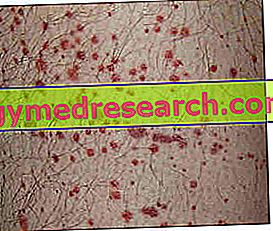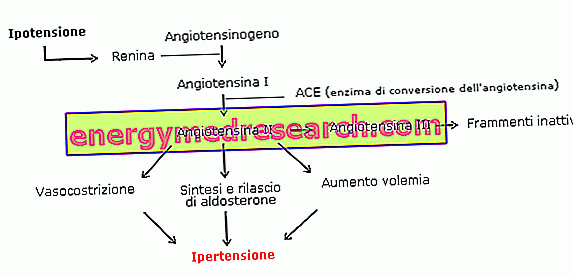In hypertension therapy the diet plays an important role, which in many cases even becomes therapeutic; for this reason it must be a subject of medical competence, to which the guidelines set out in this article are in no way intended to replace.

Salt and other risk factors
To learn more: Salt, Sodium and Hypertension

The role of sodium is in fact shaded by many other predisposing factors, such as eating habits in a broader sense (caloric and lipid excesses favor the appearance of the disease), genetic predisposition, sedentary lifestyle and lifestyle (stress, smoking, abuse of alcohol or drugs etc.).
In both the preventive and therapeutic fields, the hypertension diet is based on four fundamental points:
- contain sodium intake (see: food low in sodium)
- increase that of potassium (through a generous consumption of fruit, vegetables and whole foods)
- control body weight and limit alcohol consumption.
The sodium intake should be reduced below 3-5 grams a day, thanks to the reduction of salt consumption (or its replacement with similar sodium hydroxides) and sodium-rich foods. In various studies, the shift from a typical diet in industrialized countries (which provides ten or more grams of sodium a day) to a low-salt diet has been shown to reduce arterial pressure by 2-8 mmHg. In this regard, it is good to remember that one gram of normal table salt contains 400 mg of sodium; consequently, a pinch of salt brings about one gram of sodium, while a teaspoon brings 5, a spoon 15 and a punch 30.
How to Reduce Salt Consumption
Limiting the addition of salt to foods may seem difficult, but in reality there is nothing simpler; the palate, in fact, can be educated, and if the reduction takes place gradually, it will get used to the new diet without too many problems, finding tasty dishes that until recently seemed insipid; the salt can also be substituted with low-sodium products (for example containing potassium chloride) or various aromas and spices, such as chilli, herbs, garlic, parsley, rosemary, sage and oregano. In this sense, parents have a great responsibility towards their children, who must be directed, from the earliest years of life, to a diet poor in snacks and salt-rich snacks.
Once the addition of sodium is reduced, the consumption of the foods in which it is present in large quantities must also be reduced; packaged food and cured meats, for example, are two of the main obstacles to reducing sodium in the diet. Moreover, these are generally high-calorie foods, which increase the stimulus of thirst, often appeased with sugary or alcoholic drinks. Beware also of stock cubes and preparations for flavoring dishes - widely used in restaurants, especially in eastern ones - because they are rich in monosodium glutamate.
The daily sodium requirement is about 400 mg, a value much lower than the amount assumed by many people (even 20 times greater), which increases in febrile episodes, in case of profuse sweating (including that induced by physical activity), excesses of vomiting and diarrhea.
Sodium in food
Generally speaking, sodium is abundant in animal foods (especially if seasoned, such as cheeses and cured meats) and is scarce in vegetable ones, which are instead richer in potassium (artichokes, beets, celery, carrots, turnips, spinach and cabbage contain more sodium than other commonly used vegetables). Obviously, sodium also abounds in foods preserved in salt or in brine, such as capers, some fish and olives.
| FOOD | Sodium (mg / 100g) | FOOD | Sodium (mg / 100g) |
| beef steak | 60 | tomato | 3 |
| frozen steak | 1300 | Ketchup | 1040 |
| pork fillet | 290 | peas | 1 |
| sausage | 1100 | canned peas | 230 |
| chicken | 50 | peanut | 5 |
| lard | 68 | peanut butter | 600 |
| fresh salmon | 48 | potato | 3 |
| smoked salmon | 520 | French fries | 1000 |
| flounder, sole | 80 | onion | 10 |
| sardines with tomatoes | 40 | vinegar onions | 1420 |
| oyster | 73 | natural popcorn | 3 |
| frozen capa santa | 206 | salty popcorn | 1940 |
| cabbage | 20 | puffed rice | 360 |
| sauerkraut | 750 | whole cow's milk | 50 |
| asparagus | 2 | breast milk | 16 |
Potassium in food
As anticipated, the reduction in sodium consumption must be accompanied by an increased potassium intake; this mineral can in fact be considered a real antidote to sodium, so that the adequacy of its contribution guarantees a better blood pressure control and, in some cases, reduces the need to resort to antihypertensive drugs (hence the importance, if you already suffer from hypertension, consult your doctor before changing your dietary habits).
Potassium is found mainly in whole grains, fruit and vegetables.
| CONTENT IN POTASSIUM IN FOODS | ||
| HIGH | MEDIUM | BASS |
| Dried apricots | spinach | Parmigiano |
| Dried vegetables | Tuna in oil | wheat flour |
| Dates | walnuts | Pere |
| almonds | Artichokes | corn flour |
| peanuts | Bananas | apples |
| Mackerel | Emmenthal | |
| chestnuts | White bread | |
Additional Advice
The dietary treatment of hypertension should therefore not focus solely on the reduction of sodium consumption, but rebalance its relationship with potassium and limit excesses, especially with regard to the consumption of lipids, alcohol and high-calorie foods.
The preventive - therapeutic - behavioral framework is completed by an adequate aerobic physical activity, to be carried out at a rate not too demanding on at least three weekly occasions, with a single duration of 40 or more minutes.
The simple dietary rules reported in this article are combined with the recommendations of the so-called DASH diet (which stands for Dietary approaches to stop hypertension, ie dietary approaches to block hypertension), developed in the United States to counteract the spread of the disease and recommended by many doctors and nutritionists.
Examples Hypertension diet
Example Diet Dash Example Diet for High Pressure Example Diet to Lower Pressure Useful Foods in Hypertension



